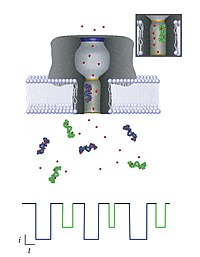
Photo from wikipedia
Solid-state nanopores have been wildly studied in the past decade due to their capability of single molecule detection. To modify the surface property of solid-state nanopores is of great interest… Click to show full abstract
Solid-state nanopores have been wildly studied in the past decade due to their capability of single molecule detection. To modify the surface property of solid-state nanopores is of great interest as it offers the opportunity to control the macroscopic response of nanofluidic devices. In this work, we present a simple and straightforward method to modify SiN nanopores based on the self-polymerization of dopamine. Previous researches have proven that polydopamine(PDOPA) performs well as binding agents for coating inorganic surfaces, forming strong covalent and non-covalent interaction with substrates. By soaking the SiN nanopore in dopamine hydrochloride solution, a thin PDOPA layer can be formed both on the surface and in the inner wall of the nanopore. We used Atomic force microscopy (AFM), X-ray photoelectron spectroscopy (XPS), contact angle measurements and Transmission microscopy (TEM) to characterize the PDOPA overlayer. We also employed I-V characteristics to measure the conductivity of the SiN nanopore before and after the polymerization modification. The responsive behavior of the PDOPA-modified SiN nanopore was also tested, hence we can evaluate the stability of the PDOPA-modified nanopores. Our experiment data indicate that the self-polymerization of dopamine provides an effective way to adjust the dimension of the pore and also can improve the rectification properties and stability of the SiN nanopore. This innovation to modify solid-state nanopores based on PDOPA polymerization offers a promising framework to explore new design concepts in nanofluidic devices.
Journal Title: Biophysical Journal
Year Published: 2017
Link to full text (if available)
Share on Social Media: Sign Up to like & get
recommendations!